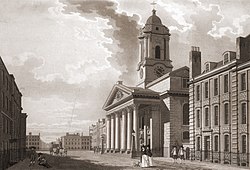St George Hanover Square
| St George Hanover Square | |
|---|---|
| Civil parish | |

The building of the church of St George's Hanover Square prompted the creation of a new parish and select vestry for church and civil purposes
|
|
 |
|
| Area | |
| • 1851 | 1,161 acres (4.70 km2) |
| • 1901 | 1,111 acres (4.50 km2) |
| • 1921 | 1,110 acres (4.5 km2) |
| Population | |
| • 1851 | 73,230 |
| • 1901 | 76,957 |
| • 1921 | 67,280 |
| Density | |
| • 1851 | 63.1/acre |
| • 1901 | 69.3/acre |
| • 1921 | 60.6/acre |
| History | |
| • Preceded by | St Martin in the Fields |
| • Origin | Commission for Building Fifty New Churches |
| • Created | 1724 |
| • Abolished | 1922 |
| • Succeeded by | City of Westminster (parish) |
| Status |
Civil parish (1724–1922) Poor law parish (1834–1870) |
| Government | St George Hanover Square Vestry (1724–1900) |
| • Type | Vestry |
| • HQ | Vestry Hall, Mount Street, Mayfair |
| Contained within | |
| • Poor Law Union | St George's (1870–1913) City of Westminster (1913–1922) |
St George Hanover Square was a civil parish in the metropolitan area of London, England. The creation of the parish accompanied the building of the Church of St George's, Hanover Square, constructed by the Commission for Building Fifty New Churches to meet the demands of the growing population. The parish was formed in 1724 from part of the ancient parish of St Martin in the Fields in the Liberty of Westminster and county of Middlesex. It included some of the most fashionable areas of the West End of London, including Belgravia and Mayfair. Civil parish administration, known as a select vestry, was dominated by members of the British nobility until the parish adopted the Vestries Act 1831. The vestry was reformed again in 1855 by the Metropolis Management Act. In 1889 the parish became part of the County of London and the vestry was abolished in 1900, replaced by Westminster City Council. The parish continued to have nominal existence until 1922. As created, it was a parish for both church and civil purposes, but the boundaries of the ecclesiastical parish were adjusted in 1830, 1835 and 1865.
The New Churches in London and Westminster Act 1710 created the Commission for Building Fifty New Churches with the purpose of building new churches to deal with the increasing population. The commission also chose the boundaries of the new parishes and selected suitable persons to be parish officers and vestrymen. Within the parish were some of the most fashionable areas of the West End of London, with an aristocratic population. The select vestry created by the commission included 100 men. Much of the population of the parish was resident for only part of the year. The parish was created in 1724 from part of the ancient parish of St Martin in the Fields. It was within the Liberty of Westminster and the county of Middlesex. The parish vestry therefore had overlapping jurisdiction with the Westminster Court of Burgesses as well as the Westminster and Middlesex sessions.
...
Wikipedia
